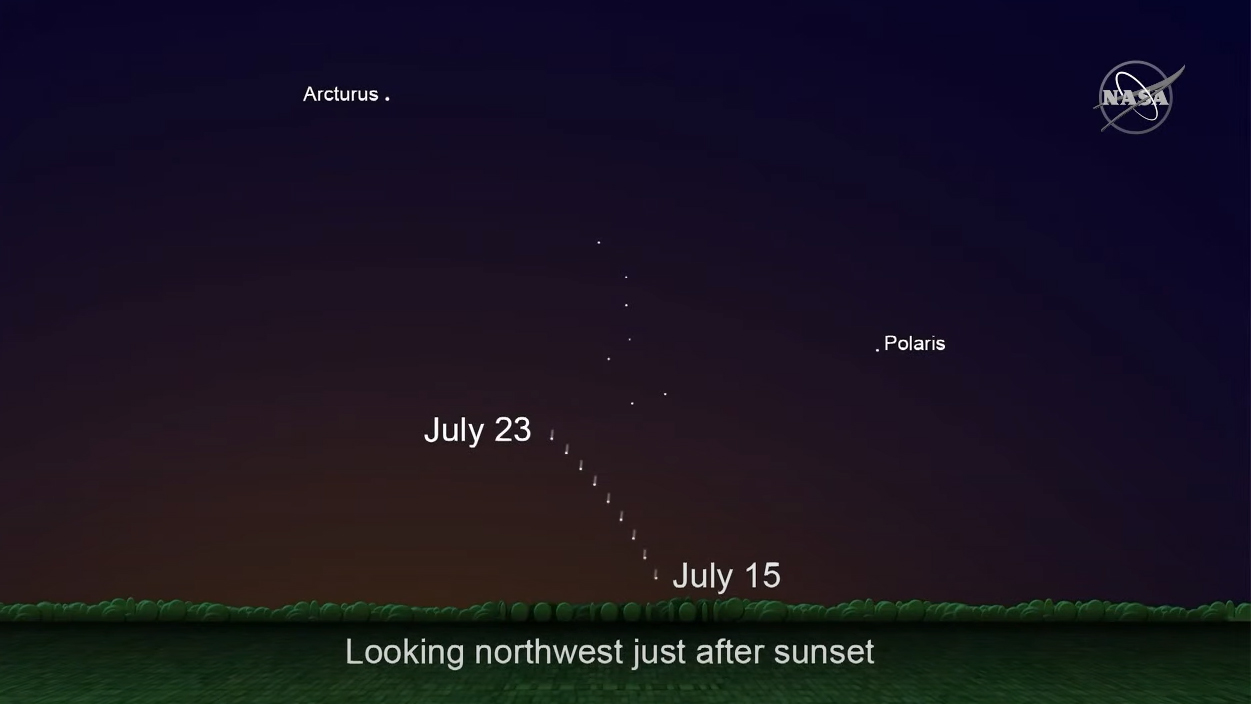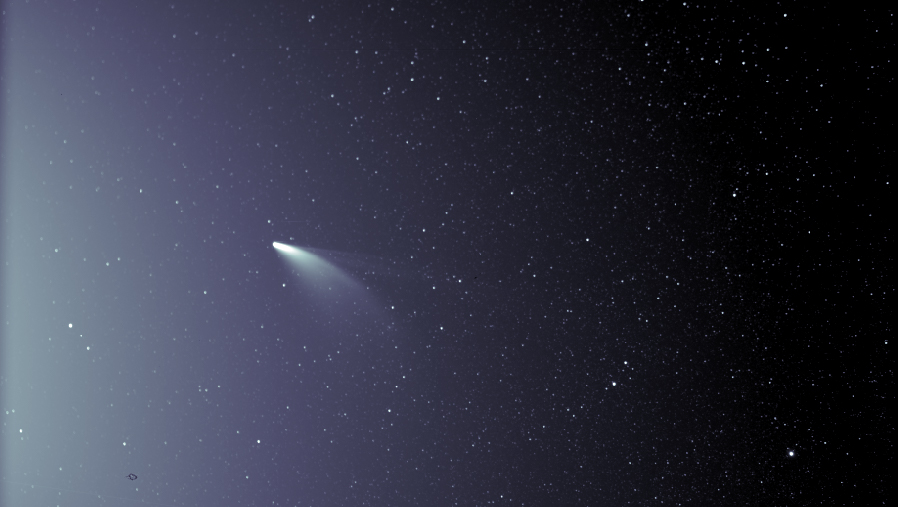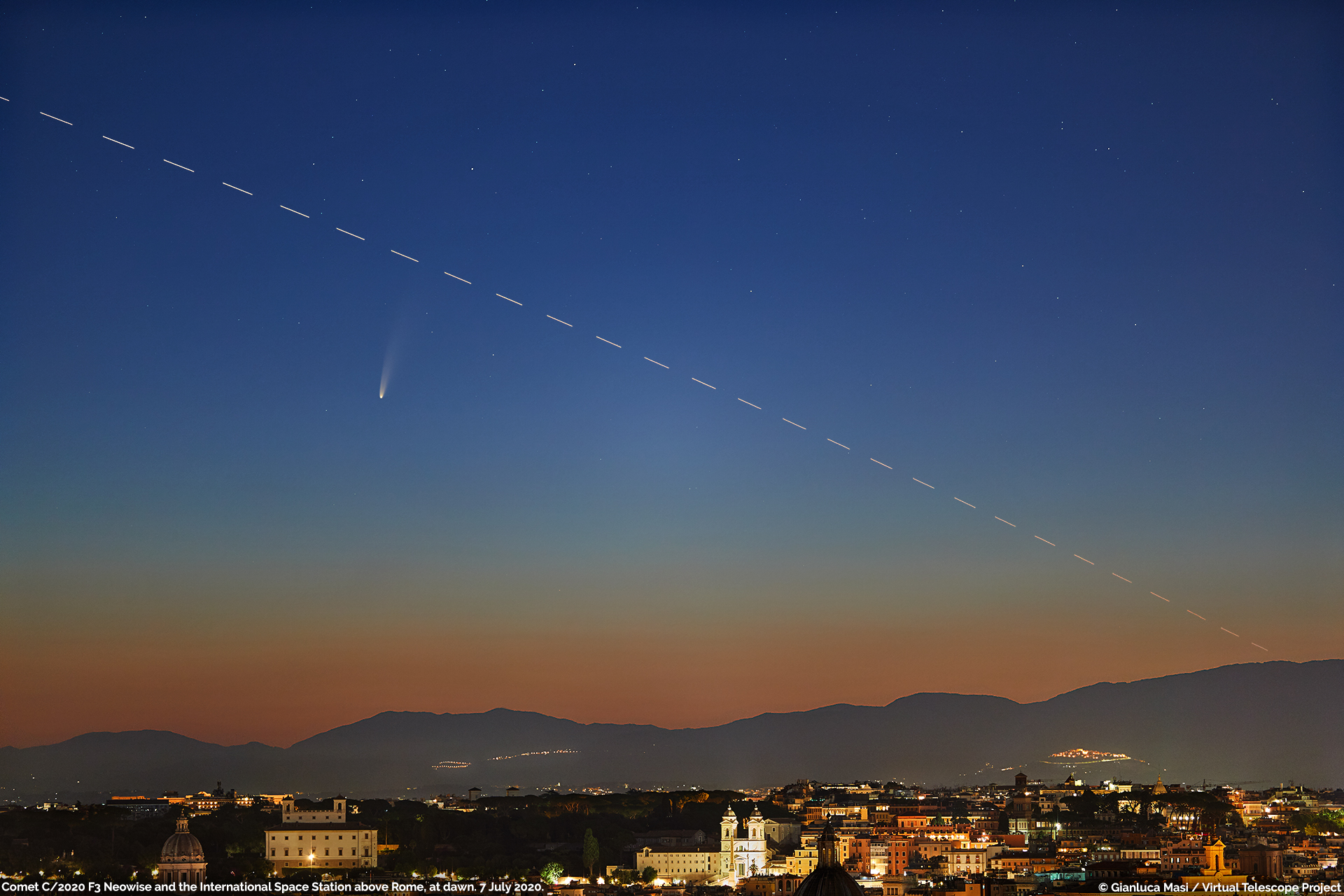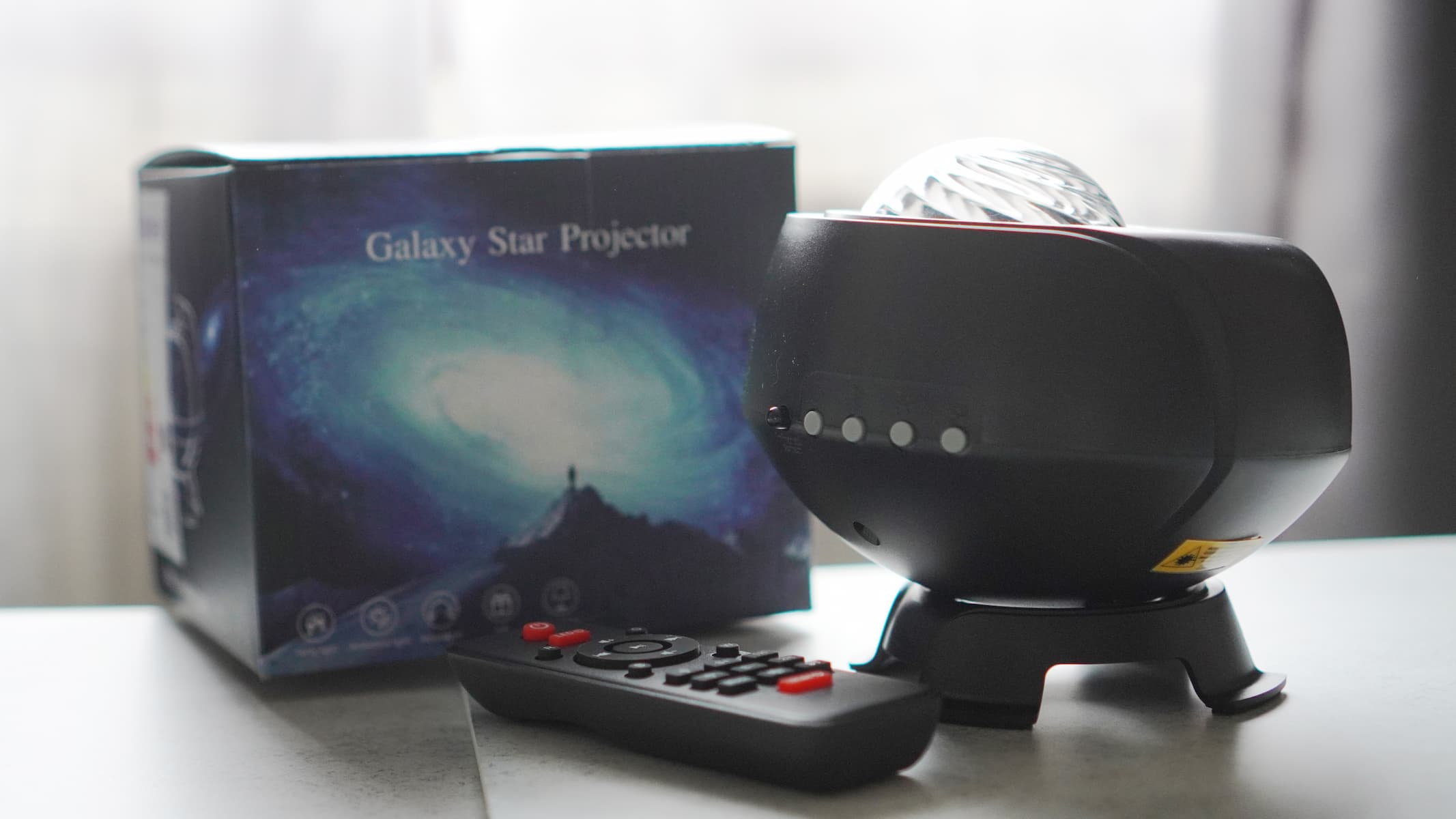How to see Comet NEOWISE in the evening sky now. It won't be back for 6,800 years.
Here's where to look, according to NASA.
An amazing comet that thrilled early-morning stargazers earlier this month is now visible in the evening sky, and it's a sight you won't want to miss. After all, this comet won't be back for 6,800 years, NASA says.
Comet NEOWISE can now be seen just after sunset for observers in the Northern Hemisphere, according to NASA. (Sorry, Southern Hemisphere skywatchers, it's not visible there.) The comet made its closest approach to the sun July 3 but was only visible before dawn until now.
"If you're in the Northern Hemisphere, you can see it," said Joe Masiero, deputy principal investigator of NEOWISE, the NASA space telescope that discovered the comet, in a NASA Science Live webcast Wednesday (July 15). "As the next couple of days progress, it will get higher in the evening sky, so you're going to want to look northwest right under the Big Dipper." (The Big Dipper is a ladle-shaped star pattern that is part of the constellation Ursa Major, the Big Bear.)
Related: How to see Comet NEOWISE in the night sky this month
More: Amazing photos of Comet NEOWISE from the Earth and space


If you spot Comet NEOWISE, let us know! Send images and comments to spacephotos@space.com to share your views.
There are a few more comet-observing tips to keep in mind, according to Masiero.
First, you're going to want to try and get away from city lights and set up in a location with a clear, unobstructed view of the northwest horizon.
Then, find out what time your local sunset is. (A tool like the Farmer's Almanac or TimeandDate.com can help.) You'll want to wait until 45 minutes after sunset before hunting the comet.
Get the Space.com Newsletter
Breaking space news, the latest updates on rocket launches, skywatching events and more!
"What you want to do is go out right around the time that the first stars start to show up. You're not going to be able to see it before that," Masiero said. "It's probably about as bright as some of the stars in the Big Dipper."
To the unaided eye, Comet NEOWISE will look like a fuzzy star with a bit of a tail, according to a NASA guide. But binoculars or a small telescope offer a much better view.
Related: Best telescopes for the money — 2020 reviews and guide
Officially known as C/2020 F3, Comet NEOWISE was first discovered in March by the infrared-optimized NEOWISE spacecraft (the name is short for Near-Earth Object Wide-field Infrared Space Explorer). Since then, the comet has been spotted by several space telescopes and observatories, astronauts on the International Space Station and, of course, stargazers on Earth.
The light from the comet is sunlight reflecting off the dazzling tail of gas and dust trailing away from NEOWISE as it drifts ever farther from the sun. A second tail made of ionized particles blown back from the comet's head (called its "coma") by the solar wind can be seen in some photos.
"This comet is about 3 miles [5 kilometers] across, and most comets are about half water and half dust," said NEOWISE science team co-investigator Emily Kramer of NASA's Jet Propulsion Laboratory, who used that statistic to calculate just how much water is in Comet NEOWISE.
"It's about 13 million Olympic swimming pools of water," she added. "So that's a lot of water."
Related: How to photograph Comet NEOWISE
Comet NEOWISE is currently about 70 million miles (111 million km) from Earth — or about thee-quarters the distance from the Earth and sun — and on an extremely elliptical orbit that carries it far out from the sun, Masiero said. Earth is about 93 million miles (150 million km) from the sun on average.
The comet is moving at about 40 miles per second — that's about 144,000 mph (231,000 km/h — but poses no threat to Earth, Masiero said.
Related: The 9 most brilliant comets ever seen

"There is no risk to the planet from this," he added. "It's very far away from us and it's not coming anywhere near us, so there is no threat."
There may be no impact threat from Comet NEOWISE, but there is a "wow" factor for skywatchers who see it, Kramer said.
"The fact that we can see it is really what makes it unique. It's quite rare for a comet to be bright enough that we can see it with the naked eye or even with just binoculars," she added. "The last time we had a comet this bright was Comet Hale-Bopp in 1995 and 1996, so it's been quite a while."
Comet Hale-Bopp, the last "Great Comet" to be visible in the night sky, was discovered in July 1995 by astronomers Alan Hale and Thomas Bopp via telescopes. It made its closest approach to Earth in 1997 and was visible to the unaided eye for 18 months.
If you snap an amazing photo or video of Comet NEOWISE in the night sky? Let us know! To share images and videos for a possible story or gallery, send images and comments in to spacephotos@space.com.
Editor's note: This story has been updated to include more details about Comet Hale-Bopp, which was discovered in 1995 but not visible to the unaided eye until 1997.
Email Tariq Malik at tmalik@space.com or follow him @tariqjmalik. Follow us @Spacedotcom, Facebook and Instagram.
Join our Space Forums to keep talking space on the latest missions, night sky and more! And if you have a news tip, correction or comment, let us know at: community@space.com.

Tariq is the Editor-in-Chief of Space.com and joined the team in 2001, first as an intern and staff writer, and later as an editor. He covers human spaceflight, exploration and space science, as well as skywatching and entertainment. He became Space.com's Managing Editor in 2009 and Editor-in-Chief in 2019. Before joining Space.com, Tariq was a staff reporter for The Los Angeles Times covering education and city beats in La Habra, Fullerton and Huntington Beach. In October 2022, Tariq received the Harry Kolcum Award for excellence in space reporting from the National Space Club Florida Committee. He is also an Eagle Scout (yes, he has the Space Exploration merit badge) and went to Space Camp four times as a kid and a fifth time as an adult. He has journalism degrees from the University of Southern California and New York University. You can find Tariq at Space.com and as the co-host to the This Week In Space podcast with space historian Rod Pyle on the TWiT network. To see his latest project, you can follow Tariq on Twitter @tariqjmalik.
-
Art Wilmoth There is more to this Comet than an amateur SPACE article! Where are all the close up footage of all the trillion dollar space equipment; Space Vehicles, and space telescopes? All we get is this amateur photo, and dribble.Reply
Mod Edit for ContentTherefore as scientists the data from the comet's DNA might shed some light on the past, or the future. The future that is, if this comet belongs to debris from another star system coming our way because of a black hole slinging planets out into space. Space is a violent dangerous place. -
davea0511 I tried to find it at 3am. Does it slip below the horizon at some point? If so when? I couldn't find it.Reply -
JLinMia I flew from Miami to London in 1997, early Feb. Had a left window and as you know winter flights are mostly night flights. I spent the whole night watching cometh Hale , too bad I didnt have an iPhone or DSLR back then.Reply
Wonderful experience.
See you all out tonight. -
davea0511 Reply
Lasts until midnight, then drops below the horizon. Watched on our telescope last night ... Soooo much better with a telescope. Tiny comet though, big plume. Jupiter opposite end of the sky (brightest object over there), and Saturn right next to it. Both easy to find. Easily see the 3 closest moons of Jupiter with a good telescope. Incredible bunch of night sky objects. Kids were thrilled.davea0511 said:I tried to find it at 3am. Does it slip below the horizon at some point? If so when? I couldn't find it. -
amobeus Reply
So many things wrong with this guys statement.Art Wilmoth said:There is more to this Comet than an amateur SPACE article! Where are all the close up footage of all the trillion dollar space equipment; Space Vehicles, and space telescopes? All we get is this amateur photo, and dribble.
The Comet is reported about the same age as when God created all life on planet Earth. That statement should mean something to the wise. Therefore as scientists the data from the comet's DNA might shed some light on the past, or the future. The future that is, if this comet belongs to debris from another star system coming our way because of a black hole slinging planets out into space. Space is a violent dangerous place.
Close up footage of Space vehicles and telescopes? Erm okay, just google Space shuttle.
Mod Edit for Content
Comets DNA? what are you on about? Do you mean the supposition that life was seeded from organic compounds rained down to earth by meteorites? Okay but that's still not DNA. Even so, how do you suppose they are going to get samples? It's travelling 144,000 Mph twice the speed of the Earth-orbiting the sun. It's going to be long gone before any mission can be launched.
Lastly, Its trajectory is in no way interstellar. So that's that out of the window. not sure what any of the black hole stuff has to do with the future.
Can't wait for the ridiculous angry reply full of wishy-washy woo science.
